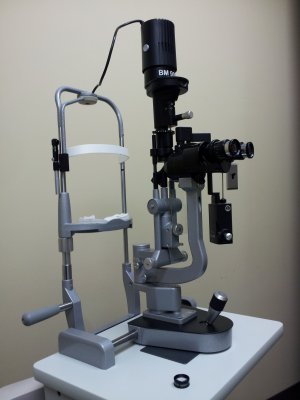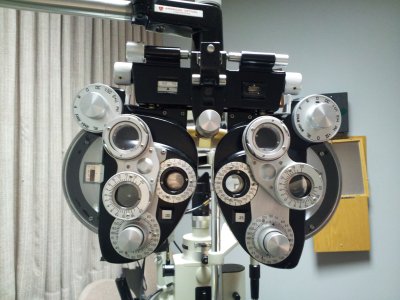Two days, two eye exams…
4 minute read
October 11, 2012, 11:58 PM
So this week, I had two eye exams on consecutive days. And that means getting my eyes dilated twice. Yay me. The reason I have two eye exams is because I also see a specialist for a retinal hole, which is stable, but the specialist wants to observe it to make sure it stays that way. Thus two eye exams – once for the retina doctor, and once for the regular eye doctor. It wouldn’t be that bad if not for the dilation. That means that after the eye exam, I’m going home and hiding in the house with the shades closed for a few hours until the drops wear off. And it would of course be my luck that it would be sunny on the days that I had my eye exams – and this isn’t even Philadelphia (where I’m told that it’s always sunny). But it was cloudy on Tuesday, but then yesterday and today, it was a beautiful day, which is exactly what I don’t want when my eyes are dilated.
One complaint about the eye exams is that there’s not enough diversity in eye charts. I’ve done this enough times, especially since I get two eye exams a year, that I’ve got the eye exam chart just about memorized. The eye chart is done with a projector, and then they use mirrors to get the full 20 feet in the exam room. This is the projector, seen here at my regular eye doctor’s office:
And then slides containing the eye charts go into the projector. Thing is, it seems that every eye doctor uses the same chart. Dr. Patel used it in Fishersville, the retina specialist uses it, and so does my regular eye doctor in Silver Spring. And then they use the same chart for both eyes. Thus I’ve got this thing just about memorized. I know that the first 20/20 line on the chart is E-V-O-T-Z-2, and the second one is T-E-G-A-D-M. I also know quite well that the 20/25 line is A-P-S-O-2-5. So they test the right eye, and then they test the left. I’m tempted to say for the left eye, after having just told them E-V-O-T-Z-2 for the right eye, “I just told you what it says. Were you not paying attention the first time?” That, however, would be totally rude, but it is one of those things that I’ve fantasized about wanting to say at an eye doctor appointment, but would never really do. When I’ve mentioned seriously that I’ve just about got these charts memorized, they mention that there are alternate charts, but they never use them with me. I looked up the eye chart online (finding it, fittingly enough, by searching on “E-V-O-T-Z-2”) to find out what the alternate charts are, and found out that there are three charts on the same slide. On the linked document, I discovered that the slide that they use for me is the 8800 slide (they’ve mentioned the presence of pictures before – thus I know it’s that one). They should use the “E” chart on me just to keep things interesting, or even go down to the pictures.
I think that the standard eye chart was most accurate with me when I first saw Dr. Patel in January 2001. Two factors worked in my favor for that. First, I had never had an eye exam before. I had never seen the eye chart before, so I didn’t know about “E-V-O-T-Z-2” yet. And then the other factor: I was having some problems seeing, which is why I was there in the first place, and so I couldn’t see the chart all that well. This was when I started wearing glasses, by the way.
Otherwise, though, I was surprised that a few methods had changed since last year. Both places stopped using the big machine to test intraocular pressure. Previously, they would take the yellow drops and put them in both eyes in order to numb them up. Then they would use this machine to do the test:
Basically, your face goes in the structure to the left, and then they tell you that you will feel a puff of air. Then the blue light comes on and goes right up to your eye and they take the measurement. Now, the numbing drops are clear, and the ocular tonometer (look it up) is a handheld device that goes right on your eye. I don’t mind the clear drops, because I never liked the yellow drops because you got yellow goop on your eyes from it. The handheld device, on the other hand, I’m not so sure about whether I like it or not. I think I might like the puff better, but who knows. I don’t get to make these decisions.
Then of course, some of the classics were still in use, like this:
This is the phoropter, which determines your prescription, i.e. which is clearer, between one and two. Good to see that some things haven’t changed.
Meanwhile, I’m going to be glad to be back at the office tomorrow. Sitting at home with the shades closed is no fun.
Categories: Personal health












